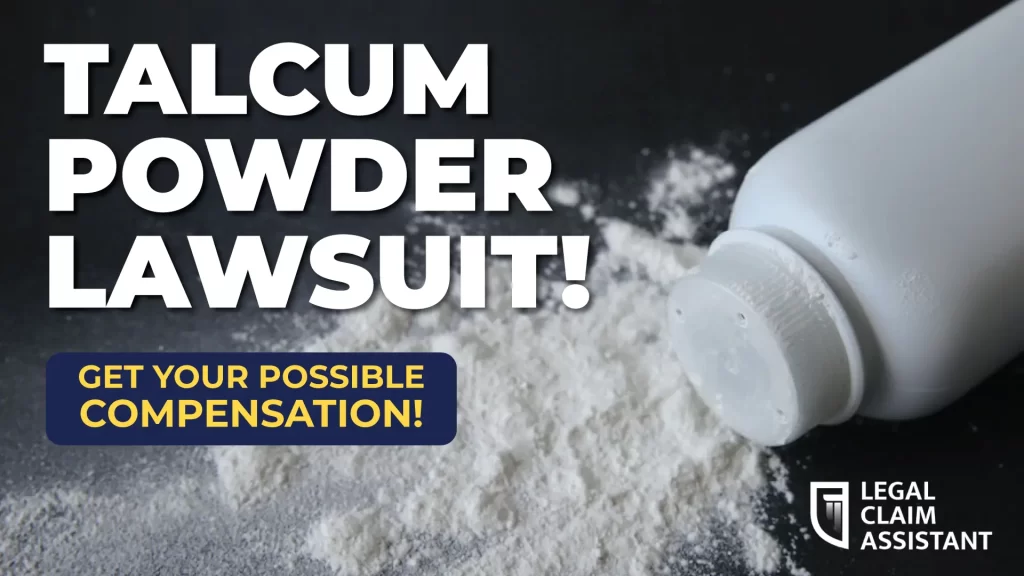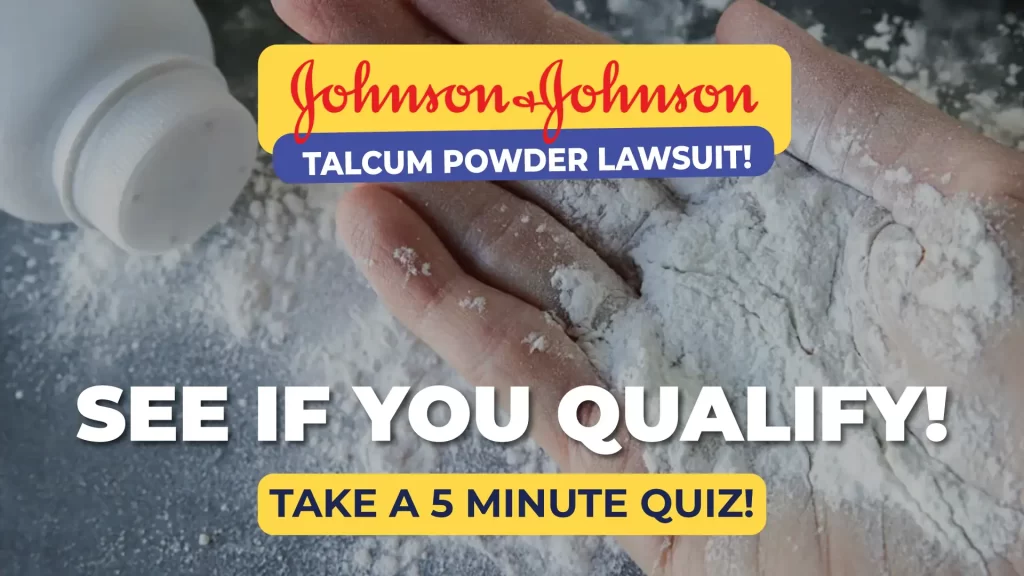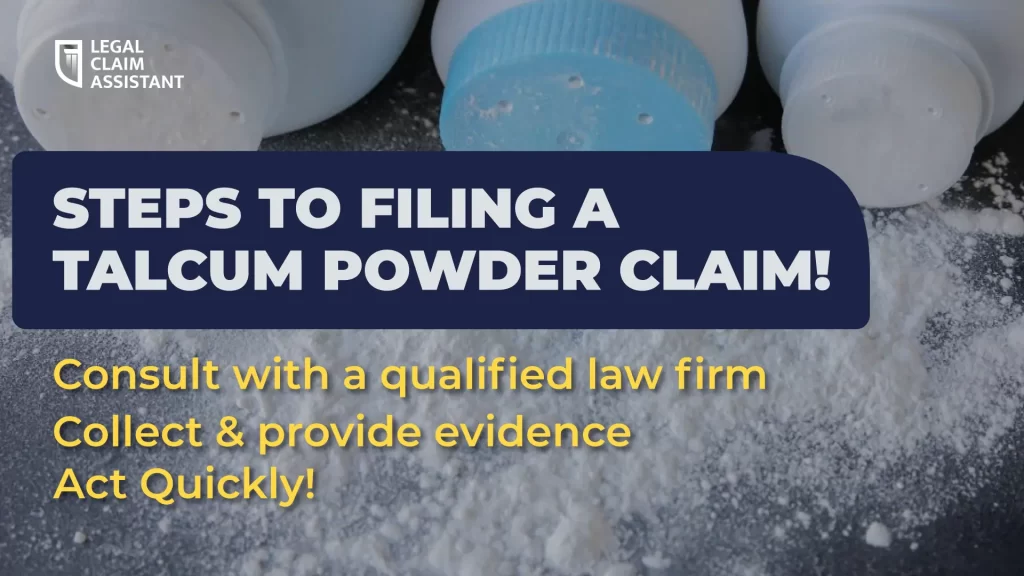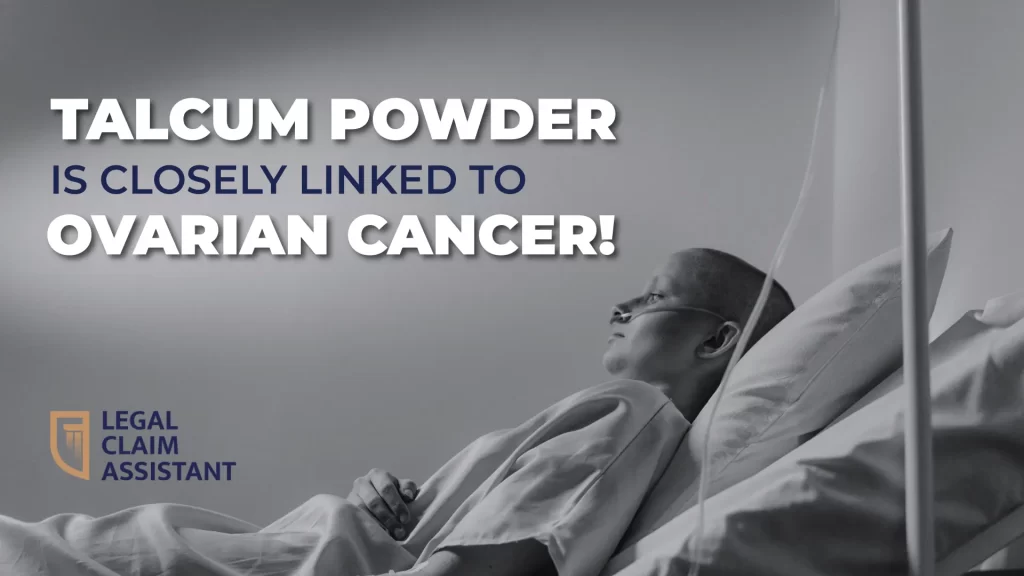Talcum Powder Lawsuit
Welcome to our focused guide on talcum powder lawsuits, specifically dealing with claims related to Johnson’s Baby Powder and other talc-based products. This resource explores significant legal challenges and the implications of prolonged exposure to talcum powder, which has been linked to serious health issues including asbestos contamination and cancer.

Written by: Sarah from Legal Claim Assistant, Last updated: April 24, 2024
Table of Contents
Understanding Talcum Powder Litigation
The surge in talcum powder lawsuits highlights serious concerns regarding consumer products like baby powder, particularly those containing talc. These cases primarily focus on allegations that prolonged use of talcum powder has led to ovarian cancer and other severe health issues due to asbestos contamination. Victims argue that manufacturers, including the giant Johnson & Johnson, failed to warn users about the potential health risks posed by talc products. The legal struggles intensify as more individuals come forward, supported by scientific causation evidence linking talcum powder to ovarian cancer and mesothelioma, an asbestos-related disease.
The Science Behind Talc and Cancer Risks
Investigations reveal that talc, a mineral composed of magnesium, silicon, and oxygen, can sometimes naturally occur alongside asbestos, a known carcinogen. This contamination can make its way into talc products like baby powder. Over years of use, these asbestos fibers can cause inflammation in ovarian tissues or the lungs, potentially leading to cancer. Scientific studies and trials continue to explore and confirm these associations, affecting litigation strategies and outcomes.
Key Legal Battles and Court Decisions
In pivotal legal battles, such as those faced by Johnson & Johnson, courts have sometimes awarded substantial compensations to plaintiffs, recognizing the link between talcum powder and cancer. The Missouri Circuit Court of Appeals and New Jersey Bankruptcy Court have seen significant cases where juries and judges have ruled on the side of plaintiffs, leading to large settlements and restructuring plans, like the $8.9 billion proposed by J&J to settle claims. These decisions not only influence individual cases but also shape the landscape of consumer protection claims and mass tort bankruptcy cases involving talcum products.
Through these legal battles and ongoing litigation, awareness of the dangers of talcum powder continues to increase, pushing for more stringent regulations and reformulations of products to eliminate asbestos contamination, thereby safeguarding public health.

The Link Between Talcum Powder and Ovarian Cancer
The Link Between Talcum Powder and Ovarian Cancer
The association between talcum powder and ovarian cancer has prompted numerous lawsuits, positioning talcum powder litigation as a significant legal and health concern. These claims primarily involve women who have developed ovarian cancer after prolonged use of talc-based products, such as Johnson’s Baby Powder and other similar cosmetic talc products.
Studies and lawsuits allege that talcum powder, when applied to the genital area, can travel through the vagina, uterus, and fallopian tubes to the ovaries, where the talc particles can cause inflammation. This inflammation may lead to the growth of cancer cells, culminating in ovarian cancer over time. The presence of asbestos, a known carcinogen found in some talcum powder products due to natural deposits, exacerbates these risks. Asbestos exposure itself is linked to mesothelioma, but its role in ovarian cancer via contaminated talc has been a significant point in talcum powder cancer lawsuits.
Legal Actions and Court Decisions
Litigation against companies like Johnson & Johnson has grown, with plaintiffs claiming that the company failed to warn users about the risks associated with its talcum powder products. In several high-profile cases, courts have ruled in favor of the plaintiffs, leading to substantial settlements. For example, a St. Louis jury awarded $4.7 billion to 22 women in 2018, which was one of the largest sums in such lawsuits.
Moreover, Johnson & Johnson faces thousands of cases consolidated under a multidistrict litigation (MDL) framework, aiming to handle the massive scope of these lawsuits efficiently. This MDL has seen various outcomes, including Johnson & Johnson’s decision to stop selling its talc-based baby powders in North America and subsequent moves toward bankruptcy protection for its talc subsidiary to manage potential liabilities, which are estimated to be around $8.9 billion.
Implications for Consumers and Industry
These legal battles have not only highlighted significant health risks posed by talcum powder but also spurred changes in product formulations and consumer protection policies. The lawsuits have led to increased scrutiny of talc products and their safety, pushing companies to verify the absence of asbestos or consider switching to safer alternatives like cornstarch-based powders.
The ongoing litigation and the scientific community’s efforts to understand and mitigate these risks continue to influence public health policies and consumer safety standards, ensuring better protection and transparency for all users of talcum-based products.
Need help filing a Talcum Powder Claim?

Asbestos Contamination in Talcum Powder
Asbestos Contamination in Talcum Powder
The discovery of asbestos contamination in talcum powder products has sparked widespread concern and litigation, given the serious health risks associated with asbestos exposure. Asbestos, a known carcinogen, when inhaled or absorbed through prolonged contact, can lead to severe health conditions, including mesothelioma and ovarian cancer.
Legal and Health Implications
Lawsuits against companies like Johnson & Johnson allege that consumers developed ovarian cancer and other illnesses after using talcum powder contaminated with asbestos. These talcum powder lawsuits argue that the companies failed to adequately test talcum products for safety or warn consumers about the risks. Notably, the Johnson’s Baby Powder mesothelioma trial and other cases have highlighted the potential health risks posed by asbestos in consumer products.
Many of these cases have progressed through various courts, including New Jersey’s bankruptcy court, where Johnson & Johnson’s bankrupt talc subsidiary sought to manage liabilities through a third bankruptcy filing. This strategic move was aimed at consolidating thousands of talc lawsuits alleging that prolonged use of talc-based products led to cancer due to undisclosed asbestos contamination.
Financial and Regulatory Impact
The financial impact of these lawsuits has been profound, with companies facing potential settlement payments running into billions, as indicated by the $8.9 billion contemplated in consensual bankruptcy resolution. Additionally, these lawsuits have prompted calls for stricter regulations on cosmetic talc products and better oversight by agencies like the state consumer protection claims bodies to ensure product safety.
Consumer Awareness and Safety Measures
This situation has also intensified the scrutiny of talcum powder products, driving a shift towards asbestos-free alternatives and increasing consumer awareness about the ingredients in personal care products. The ongoing litigation continues to influence public health policies, aiming to protect consumers from the hidden dangers of asbestos and ensure that product manufacturers uphold stringent safety standards.
Major Talcum Powder Lawsuits and Settlements
The litigation surrounding talcum powder products, notably those produced by Johnson & Johnson, represents some of the most significant legal battles over consumer goods safety in recent decades. These lawsuits have highlighted serious concerns about the potential health risks posed by talcum powder, especially its alleged links to ovarian cancer and mesothelioma due to asbestos contamination.
Notable Cases and Legal Outcomes
One of the most prominent cases involved Johnson & Johnson, whose baby powder, made from talc-based products, was claimed by thousands of plaintiffs to contain asbestos that led to cancer. In a landmark decision, a Missouri circuit court awarded $4.7 billion to 22 women, marking one of the largest verdicts in such lawsuits. This case underscored the severity of claims regarding ovarian cancer risks associated with long-term talcum powder use.
The lawsuits have also pushed the company towards major financial settlements. Notably, Johnson & Johnson agreed to a $100 million settlement to resolve over 1,000 talcum powder lawsuits. This is part of an ongoing effort by the company to settle claims out of court, which includes a massive $8.9 billion planned for potential settlement payments as part of a contemplated consensual bankruptcy resolution.
Bankruptcy and Repercussions
Amidst growing financial distress and legal liabilities, Johnson & Johnson’s bankrupt talc subsidiary filed for bankruptcy, a move scrutinized and contested in various courts. This bankruptcy filing, overseen by Bankruptcy Judge Michael Kaplan in New Jersey, aims to consolidate claims and manage settlements more effectively.
Moreover, the asbestos litigation has led to significant changes in how talcum products are produced and marketed. Companies like Johnson & Johnson have discontinued their talc-based baby powders in North America, transitioning to cornstarch-based products amidst rising safety concerns and declining consumer trust.
Implications for Future Litigation
These cases have not only led to substantial settlements but have also spurred changes in state consumer protection claims and regulations concerning cosmetic talc products. As legal battles continue, including appeals and further trials, the outcomes of these cases are closely watched by law firms and plaintiffs across the country, offering precedents for handling similar claims related to product safety and public health risks.

Navigating the Legal Process in Talcum Powder Lawsuits
Navigating a talcum powder lawsuit involves complex legal proceedings that require meticulous preparation and understanding of both the litigation process and the specific claims involved. These lawsuits typically address allegations that talcum powder products, such as Johnson & Johnson’s baby powder, contain asbestos that has led to ovarian cancer and other serious health issues.
Steps to Filing a Talcum Powder Claim
The first step in initiating a talcum powder lawsuit is to consult with a qualified law firm that specializes in product liability and mass tort cases. This initial consultation is usually free and helps potential claimants understand their legal options. Plaintiffs need to provide evidence of their talc product usage, medical records detailing their diagnosis, and any documentation linking their condition to talc exposure.
What to Expect During the Litigation Process
Once a claim is filed, the litigation process may vary based on whether the case is handled individually or as part of a multidistrict litigation (MDL). For talcum powder cases, many have been consolidated into an MDL to streamline proceedings due to the large number of plaintiffs. This consolidation helps manage pre-trial activities like discovery, which involves gathering additional evidence, interviewing expert witnesses, and developing a case strategy.
Throughout the trial, plaintiffs’ attorneys present evidence showing how talcum powder products caused harm due to their asbestos content and argue for compensation based on damages like medical bills, lost wages, and pain and suffering. Key aspects of the litigation include demonstrating the product’s risks, the manufacturer’s knowledge of these risks, and the failure to warn consumers adequately.
The process involves various stages, including motions, hearings, and, potentially, settlement negotiations. If a settlement is not reached, the case may go to trial where a jury or judge will determine the outcome based on the presented evidence.
Mass Tort Bankruptcy Case
In some situations, as with Johnson & Johnson’s talc bankruptcy, companies might seek a bankruptcy resolution to handle claims. This involves a bankruptcy court, such as the New Jersey bankruptcy court overseeing J&J’s bankrupt talc unit, which evaluates the merits of the claims and the proposed settlement amounts. This bankruptcy filing is part of a strategy to manage liabilities and provide compensation to thousands of affected users under a contemplated consensual bankruptcy resolution.
Throughout these lawsuits, settlements have varied significantly, with some reaching up to $8.9 billion in proposed resolutions. Each case’s outcome depends heavily on the quality of the legal representation, the specifics of the plaintiff’s talcum powder use, and the link established between product use and the development of cancer or other ailments.
For individuals who developed cancer or other severe health conditions potentially due to talc exposure, it is crucial to engage with experienced talcum powder lawyers who can navigate these complex legal waters effectively. These attorneys play a critical role in managing the litigation, advising on legal rights, and ensuring that plaintiffs receive the compensation they are entitled to under the law.
Role of Johnson & Johnson in Talcum Powder Controversies
Johnson & Johnson (J&J), a prominent figure in the talcum powder lawsuits, has faced substantial legal scrutiny over its baby powder products. The company has been at the center of numerous lawsuits alleging that its talcum powder, marketed under the brand name Johnson’s Baby Powder, causes ovarian cancer and mesothelioma due to asbestos contamination. These claims have led to numerous ovarian cancer lawsuits and talc cancer lawsuits, challenging J&J’s assertions about the safety of its talc-based products.
Significantly, the company’s talc supplier, Whittaker, and other related entities have been implicated in these disputes, spotlighting the broader issue of asbestos exposure from cosmetic talc products. J&J’s response to these accusations included a controversial bankruptcy filing by its bankrupt talc subsidiary, aimed at resolving claims through a mass tort bankruptcy case, which has been met with resistance and skepticism in legal circles, notably in the New Jersey bankruptcy court.
This legal strategy, which has involved tens of thousands of talc injury claimants, proposes an $8.9 billion settlement to resolve existing and future claims, a move scrutinized under multiple state consumer protection claims and asbestos litigation frameworks. Despite this, J&J has consistently denied the presence of asbestos in its products and disputes the link between its talcum powder and cancer diagnoses, a stance that has repeatedly been tested in court rulings, including several high-profile talc trials and appeals.
Find out how much your Talcum Powder payout could be:

Impact of Bankruptcy Filings on Talcum Powder Cases
The bankruptcy filings by Johnson & Johnson’s talc subsidiary have significantly influenced the landscape of talcum powder lawsuits. These strategic filings aim to consolidate and resolve tens of thousands of claims through a mass tort bankruptcy case, notably involving ovarian cancer and asbestos litigation. The company asserts that this approach will streamline the settlement process for talcum powder lawsuits, including both ovarian cancer lawsuits and other talc cancer lawsuits linked to asbestos exposure.
This bankruptcy strategy, however, has raised concerns among plaintiffs and their lawyers. Many fear that it might limit the potential compensation for individuals who developed cancer, specifically ovarian cancer, due to prolonged exposure to cosmetic talc products like Johnson’s Baby Powder. The $8.9 billion contemplated consensual bankruptcy resolution is intended to cover all current and future claims, ensuring that talc plaintiffs, including those with new talcum powder lawsuits, are compensated without the prolonged process of individual talc trials. This move has reshaped how talcum powder cases are handled in courts, including the circuit court of appeals and has set a precedent in how large corporations might mitigate extensive financial liabilities from product-related health claims.

Compensation for Victims of Talcum Powder Exposure
Victims of talcum powder exposure, particularly those who have developed ovarian cancer or other serious health conditions, often seek compensation through talcum powder lawsuits. These lawsuits target manufacturers like Johnson & Johnson, alleging that prolonged exposure to talc-based products like Johnson’s Baby Powder has led to serious health issues, including cancer diagnoses.
The compensation mechanisms in these cases can involve significant talc powder settlements. For instance, Johnson’s bankrupt talc subsidiary has been central to the litigation and bankruptcy filings, aiming to manage the financial liabilities from thousands of talc cases. These settlements often consider the severity of the health impact, such as ovarian cancer claims or other asbestos-related illnesses, which can lead to substantial financial distress for the affected individuals.
Legal firms specializing in talcum powder lawsuits advocate for victims by navigating complex legal landscapes that include mass tort bankruptcy cases and individual claims. Settlement amounts in these cases can be substantial; for example, Johnson & Johnson’s talc plaintiffs have seen figures like $8.9 billion discussed in bankruptcy resolutions to settle claims.
For victims, compensation can cover a range of damages, including medical bills from ovarian cancer treatment, lost wages, and pain and suffering. The goal of talcum powder lawyers is to ensure that all affected— from baby powder users to those handling talc containing products—are duly compensated. This process often involves detailed evidence gathering, from detecting asbestos in talc products to linking these to health issues, ensuring that the court-ruled settlements address the full scope of the plaintiffs’ losses.
Need help with your Claim?
Health Monitoring and Support for Talcum Powder Victims
For individuals affected by talcum powder-related conditions such as ovarian cancer, ongoing health monitoring and support are critical. This necessity arises especially for those involved in talcum powder lawsuits, where the demonstration of long-term health impact plays a crucial role in legal outcomes.
The extensive use of products like Johnson’s Baby Powder and other talc-based baby powders has led to significant legal scrutiny and litigation due to potential asbestos contamination and associated health risks. Many plaintiffs have brought forward claims, supported by law firms specializing in such cases, asserting that prolonged use of these cosmetic talc products has led to serious health conditions, including ovarian cancer.
Health monitoring for these individuals often involves regular medical check-ups to detect early signs of worsening conditions or new cancer diagnoses, which are crucial for updating the status within ongoing or new talcum powder lawsuits. Given the severe implications, such as the financial distress and health decline faced by the plaintiffs, comprehensive support systems are essential.
Legal teams, often part of mass tort bankruptcy cases involving companies like Johnson’s bankrupt talc subsidiary, work to secure compensation through settlements or court verdicts. For instance, the talcum powder MDL (multidistrict litigation) and other talc lawsuits have seen companies setting aside massive amounts like $8.9 billion for settlement funds, aiming to resolve claims from thousands of affected users.
Support for talcum powder victims extends beyond legal assistance; it includes emotional and psychological counseling to help manage the stress and trauma of their conditions and the complex legal processes involved. Many law firms coordinate with health professionals to ensure their clients receive comprehensive care tailored to the specific repercussions of talc exposure, including managing symptoms directly related to asbestos exposure and other talc-related liabilities.
For individuals like the Illinois woman cited in recent asbestos litigation, these comprehensive health monitoring and support services provided through the legal process are not just beneficial but necessary to cope with the profound impacts of their diagnoses.
Need help with your Johnson & Johnson Claim?

Future of Talcum Powder Products and Legal Frameworks
The future of talcum powder products and their legal frameworks is deeply influenced by ongoing litigation and evolving consumer awareness. Amidst a surge in talcum powder lawsuits, particularly those linking talc-based products to ovarian cancer and asbestos contamination, manufacturers and law firms are navigating a complex landscape.
Historically, products like Johnson’s Baby Powder have been household staples. However, recent legal challenges and public scrutiny have led to significant changes. Notably, Johnson & Johnson’s bankrupt talc subsidiary highlights the financial impact of these lawsuits, with the company setting aside approximately $8.9 billion for talc claim settlements. This financial distress is echoed across the industry as talc products face allegations of being inherently unsafe due to potential asbestos contamination.
The shift in the legal framework is largely driven by talcum powder MDLs (multidistrict litigations) and individual talc lawsuits that have spotlighted the health risks associated with talc-based products. These legal battles often focus on the failure of companies like J&J to warn users about the cancer risks, leading to ovarian cancer claims and wrongful death claims among talcum plaintiffs.
Law firms specializing in talc litigation continue to support talc plaintiffs, emphasizing the need for stricter regulations and transparency regarding the asbestos content in cosmetic talc products. This advocacy is crucial in shaping a safer market landscape and ensuring that companies are held accountable for their talc liabilities.
As talc trials proceed and more victims come forward, the industry might see a decline in the availability of talc-containing products or a shift to safer alternatives. Additionally, ongoing asbestos litigation ensures that the conversation around talc safety remains pertinent, potentially leading to more stringent regulatory measures and a reevaluation of how talc products are tested and marketed. This evolving legal and regulatory environment aims to better protect consumers and guide companies in offering safer personal care products.
Conclusion and help from Legal Claim Assistant
As the complexities of talcum powder litigation continue to unfold, victims of asbestos contamination and ovarian cancer claims find themselves at a crossroads. The numerous talc lawsuits, including high-profile cases against manufacturers like Johnson & Johnson, underscore the potential health risks posed by talc-based baby powder and other cosmetic talc products. These legal battles, exemplified by the talcum powder MDL and various individual lawsuits, highlight significant concerns over asbestos contamination and the link to cancer diagnosis.
Legal Claim Assistant stands as a vital resource for those affected. As a leading law firm specializing in mass tort bankruptcy cases and talc litigation, Legal Claim Assistant offers comprehensive support to talc plaintiffs. Whether navigating the intricacies of a baby powder lawsuit or fighting for rightful compensation in ovarian cancer lawsuits, our firm is equipped to advocate for those developed cancer from unsafe products.
With an ongoing commitment to securing justice, Legal Claim Assistant helps clients understand their rights within the sprawling scope of talc cases and claims. Our involvement extends beyond the courtroom to ensure that each client potentially sharing in the $8.9 billion set aside for settlements receives the support and guidance needed to address their wrongful death claims and other legal needs.
Written by:
Nicky from LegalClaimAssistant.com
LegalClaimAssistant.com simplifies the process of pursuing legal action. Access information, lawsuit guides, and updates on drugs, products, and other matters that may impact you.
4 References
- Holpuch, Amanda. “Two Army Veterans Awarded $110 Million in 3M Earplug Lawsuit.” The New York Times. January 28, 2022. Retrieved on May 12, 2022 from https://www.nytimes.com/2022/01/28/us/veterans-earplugs- 3m-lawsuit.html
- LexisNexis® Legal Insights. “Product liability & strict liability.” January 06, 2021. Retrieved on May 5, 2022 from https://www.lexisnexis.com/community/insights/legal/b/thought-leadership/posts/understanding-the- interplay-between-strict-liability-and-products-liability
- National Highway Traffic Safety Administration. “Letter to Tesla: Full Self-Driving Software May Cause Crash.” Retrieved from: https://static.nhtsa.gov/odi/rcl/2023/RCAK-23V085-2525.pdf. Accessed on February 17, 2023.
- Unified Parkinson’s Advocacy Council. “Paraquat Dichloride Registration Review.” July 24, 2017. Retrieved on May 12, 2022 from https://files.michaeljfox.org/Paraquat_letter_FINAL.pdf



